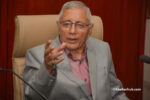NEW DELHI: The world’s largest democratic election could also be one of its most consequential.
With a population of over 1.4 billion people and close to 970 million voters, India’s general election pits Prime Minister Narendra Modi, an avowed Hindu nationalist, against a broad alliance of opposition parties that are struggling to play catch up.
The 73-year-old Modi first swept to power in 2014 on promises of economic development, presenting himself as an outsider cracking down on corruption. Since then, he has fused religion with politics in a formula that has attracted wide support from the country’s majority Hindu population.
India under Modi is a rising global power, but his rule has also been marked by rising unemployment, attacks by Hindu nationalists against minorities, particularly Muslims, and a shrinking space for dissent and free media.
How does the election work?
The six-week-long general election starts on April 19 and results will be announced on June 4. The voters, who comprise over 10% of the world’s population, will elect 543 members for the lower house of Parliament for a five-year term.
The polls will be held in seven phases and ballots cast at more than a million polling stations. Each phase will last a single day with several constituencies across multiple states voting that day. The staggered polling allows the government to deploy tens of thousands of troops to prevent violence and transport election officials and voting machines.
India has a first-past-the-post multiparty electoral system in which the candidate who receives the most votes wins. To secure a majority, a party or coalition must breach the mark of 272 seats.
While voters in the United States and elsewhere use paper ballots, India uses electronic voting machines.
Who is running?
Modi’s Bharatiya Janata Party and his main challenger, Rahul Gandhi of the Indian National Congress, represent Parliament’s two largest factions. Several other important regional parties are part of an opposition bloc.
Opposition parties, which have been previously fractured, have united under a front called INDIA, or Indian National Developmental Inclusive Alliance, to deny Modi a third straight election victory.
The alliance has fielded a single primary candidate in most constituencies. But it has been roiled by ideological differences and personality clashes — and has not yet decided on its candidate for prime minister.
Most surveys suggest Modi is likely to win comfortably, especially after he opened a Hindu temple in northern Ayodhya city in January, which fulfilled his party’s long-held Hindu nationalist pledge.
Another victory would cement Modi as one of the country’s most popular and important leaders. It would follow a thumping win in 2019, when the BJP clinched an absolute majority by sweeping 303 parliamentary seats.
The Congress party managed only 52 seats.
What are the big issues?
For decades, India has clung doggedly to its democratic convictions, largely due to free elections, an independent judiciary, a thriving media, strong opposition and peaceful transition of power. Some of these credentials have seen a slow erosion under Modi’s 10-year rule, with the polls seen as a test for the country’s democratic values.
Many watchdogs have now categorized India as a “hybrid regime” that is neither a full democracy nor a full autocracy.
The polls will also test the limits of Modi, a populist leader whose rise has seen increasing attacks against religious minorities, mostly Muslims. Critics accuse him of using a Hindu-first platform, endangering the country’s secular roots.
Under Modi, the media, once viewed as vibrant and largely independent, have become more pliant and critical voices muzzled. Courts have largely bent to Modi’s will and given favorable verdicts in crucial cases.
Centralization of executive power has strained India’s federalism. And federal agencies have bogged down top opposition leaders in corruption cases, which they deny.
Another key issue is India’s large economy, which is among the fastest growing in the world. It has helped India emerge as a global power and a counterweight to China. But even as India’s growth soars by some measures, the Modi government has struggled to generate enough jobs for young Indians, and instead has relied on welfare programs like free food and housing to woo voters.
The U.N.’s latest Asia-Pacific Human Development Report lists India among the top countries with high income and wealth inequality.
VOA









Comment